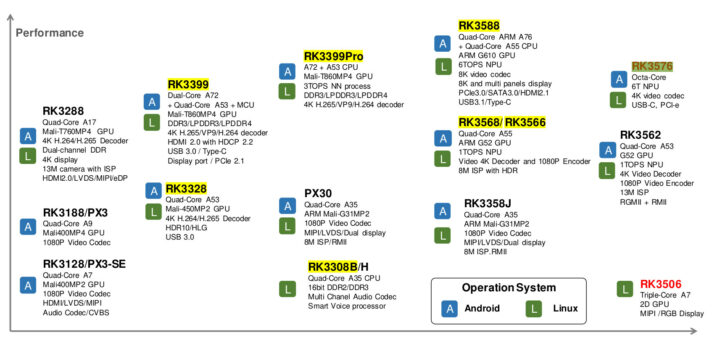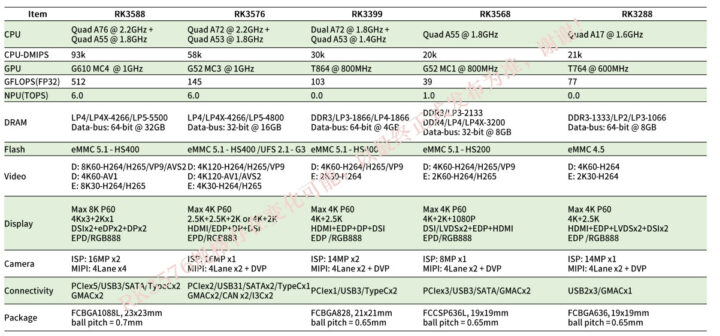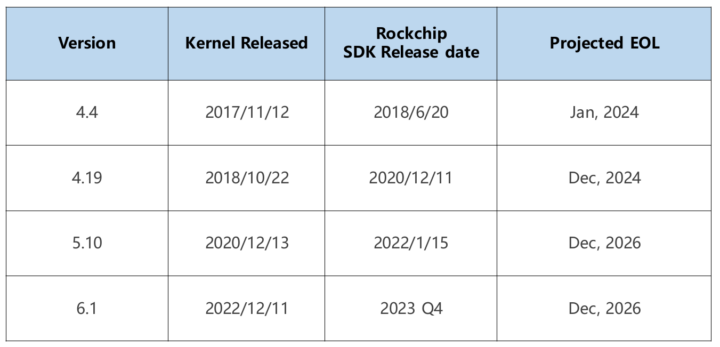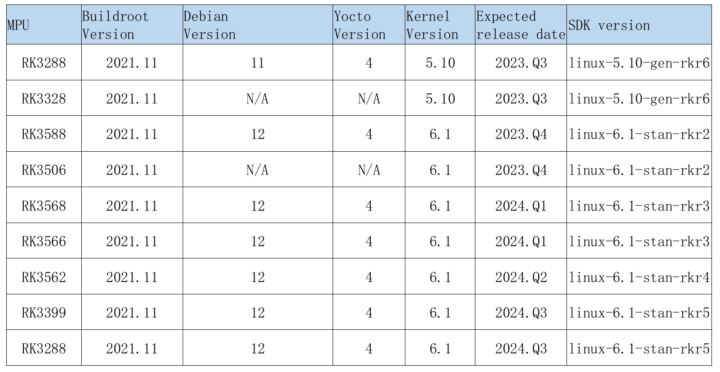The Rockchip RK3588 processor may remain the most powerful processor from the company for a while as an updated Rockchip IoT processor roadmap reveals the new RK3576 octa-core SoC and RK3506 tri-core Cortex-A7 chip, as well as a Linux 6.1 SDK to be released in Q4 2023.
With the limited information we have, the Rockchip RK3576 looks to be a cost-down version of the RK3588 processor with eight cores, a 6 TOPS NPU, a 4K video codec, as well as PCIe and USB-C interfaces. Strangely the Rockchip RK3582 that should serve a similar purpose is not showing up in the roadmap. [Update: The RK3576 is indeed a lower-cost SoC but features four Cortex-A72 and four Cortex-A53 cores instead as per the comparison table reproduced below:
That also means we now have the RK3576 specifications (some obtained from another document too):
- CPU
- Octa-core Arm processor with 4x Cortex-A72 cores at 2.2 GHz, 4x Cortex-A53 cores at 1.8 GHz
- Arm Cortex-M0 MCU at 400MHz for user
- GPU – Arm Mali-G52 MC3 GPU
- VPU
- 4Kp120 H.265, H.264, AV1, VP9, AVS2 video decoder –
- 4Kp30 H.264/H.265 video encoder
- 4Kp30 MPEG encoder and decoder
- Supports for 4Kp120 + 2.5Kp60 + 1080p60
- NPU – 6 TOPS NPU with INT4/8/16/FP16/BF16/TF32
- Memory – 32-bit LPDDR4/LPDDR4x/LPDDR5
- Storage
- UFS 2.1 w/ HS-G3 (12Gbps)
- FSPI (Octa), eMMC 5.1, SDMMC 3.0
- Video Output
- HDMI 2.1 up to 4Kp120 or eDP 1.3 up to 4Kp60 Combo Tx
- MIPI DSI-2 up to 4K60
- DisplayPort 1.4 up to 4Kp120
- ePD (Electronic Paper Display) up to 2560×1920
- Parallel interface (RGB888) up to 1080p60
- Camera I/F
- 2x MIPI CSI-2 with D-PHY (4×1, 2×2)
- 1x MIPI CSI-2 with C/D-PHY (4×1)
- 1x 8/10/12/16-bit DVP
- Picture Quality – Deinterlace, De-noise, Zoom Manage Engine, Sharpness, Edge Smoothing, DCI-HIST, 3D-LUT, ACM, HDR
- Audio
- I2S/TDM/PCM (2x 4T4R, 3x 2T2R)
- 2x 8CH PDM
- 2x S/PDIF
- ASRC (2x 2CH + 2x 4CH)
- Networking – 2x RGMII interface, i.e. dual gigabit Ethernet
- USB – 1x USB 3.2 Gen 1 with support for Type-C Alt Mode with DisplayPort
- PCIe
- 1x PCIe 2.1/SATA 3.1/USB 3.2 Gen1 combo port
- 1x PCIe 2.1/SATA 3.1 combo port
- Other I/Os – CAN FD, I2C, SPI, UART, GPIO
- Security
- Arm TrustZone security extension
- Secure boot / key ladder / OTP
- Cipher engine (RSA, ECC, HASH, DES, AES, SHA, SM)
- Package – 16x17mm, 0.65pitch, FCCSP package

Engineering samples are expected in 2023Q4. Rockchip expects RK3576 to be found in tablets, AIoT applications, e-Ink displays, Arm PCs, and automotive applications.]
The Rockchip RK3506 will target cost-sensitive Linux IoT/HMI applications with a triple-core Cortex-A7 CPU, a 2D GPU, and MIPI and RGB display interfaces. I could not find additional public information for either RK3506 or RK3576 at this stage, and all information comes from the slides used in a September 2023 presentation with OKDO, RS components, Radxa, and Rockchip themselves.
That document also includes a kernel and SDK roadmap with Rockchip planning to release Linux 6.1 SDKs/BSPs with Debian 12 between Q4 2023 and Q3 2024 for the RK3588, RK3506 (no Debian), RK3568, RK3566, RK3562, RK3399, and RK3288 with the exact expected schedule for each SoC shown in the table below.
All targets will be supported through the Buildroot 2021.11 build system, and apart from the low-end RK3506, all targets that will get a Linux 6.1 SDK update will be supported through the Yocto 4.0 build system as well. Rockchip is supposed to keep us up-to-date on its open-source website but the pages related to the Linux kernel and the software matrix have not been updated since 2019-2020. The GitHub repo for the Rockchip Linux kernel is not getting a lot of love either with the last commit dated September 30, 2022 (Linux 5.10 branch).
Thanks to Geoffrey for the tip.

Jean-Luc started CNX Software in 2010 as a part-time endeavor, before quitting his job as a software engineering manager, and starting to write daily news, and reviews full time later in 2011.
Support CNX Software! Donate via cryptocurrencies, become a Patron on Patreon, or purchase goods on Amazon or Aliexpress









> RK3576 looks to be a cost-down version of the RK3588 processor with eight cores
Not really, the two clusters seem to feature old and boring A72/A53.
Thanks. That link does not show up in a web search… I’ve edited the post, and I’ve also received another document (not sure I can share it) with more details. One good thing is that it’s the first low-cost processor with UFS storage that I’ve seen.
Microsoft implented a quite capable search functionality all across Github in the meantime and one finds quite a lot of info and not just code by using it:
https://github.com/search?q=rk3576&type=code
The 1st link (as of today) might contain the information you received?
Yes, similar information, although I have a few more slides such as the one with the CPU and GPU performance that I included in the post.
I should probably add GitHub to Brave Search and Google when doing this type of research.
I am sometimes puzzled by China supplies where so many close varitaions don’t seem to make much sense.
I guess they have a design team and this keeps things more incremental, but with the ecomnomies of sale with the rk3588(s) who would want a RK3576 unless it could be made real cheap I can get a RK3588(s) for $66 so it would have to undercut that, but motivation often seems purely because they can
[ maybe someone could ask Rockchip directly(?), what’s their intention towards state&gov&investors/(node dependent/related)manufacturers/ARM(licenses, A72&A53 vs. A76&A55&v9.GPU(?))/customers/consumers(?), not knowing their POV
considering cost for main SoC, me guessing it’s about a $5-20(-25-60, with low availability on market for a RK3588 and in general for RK3566, RK3568 in a hundreds sale quantities) difference, while SoC design needs human resources, effort and knowledge and licenses granted ]
[ this is China&Rockchip telling it’s related participants being legislation&manufacturers&customers&consumers&all_interested
‘The 7th Rockchip Developer Conference has gathered the strength of the whole industry. We would like to share, communicate and co-create with all the participants and developers in the upstream and downstream the industrial chain. Rockchip, which actively embraces the new normality and takes AIoT as the development direction, looks forward to making breakthroughs with our partners and build a better world.’
Rockchip, please define ‘better'(?) ]
[ ‘as per the comparison table reproduced’ (vs. roadmap)
it’s getting real (then), that RK3588 is advancing towards PCIe5 (req. exposed connector?) with next versions(?), might require Cortex X4, impressive(, then), or (with limitations) a bridging add-on IC ]
Ah indeed, it just looks like what the RK3399 should have been… And not even, it only features a narrow 32-bit DRAM data bus that’s already too small for RPi4 so it will definitely be the limiting factor for 8 cores here. All a bit outdated by now, only the I/Os were refreshed. I would have imagined 8xA55 for low-power processing but not even.
[ if board designers&manufacturer don’t add new ideas for consumers being attractive it’s getting harder for marketing to advertise chances (at least stability on performance would be required?), but there’s also a mobiles market, being on/towards armv9 (more or less), &maybe manufacturers change the lead position (software related support)? ]
I always assumed roadmaps showed the latest and greatest.. not impressed
Let’s not start about their software updates, even more dissapointment
Maybe the key here, is in the specification/price ratio.
But, but… it supports 4K120 AV1!
Better late than never to see Linux 6.1 for the RK3588 as development has reached a distinctive halt in the road.
Perhaps a dev can interpret the above info to guess if their driver development process will get them into the production Linux kernel. Being stuck on an old, vendor specific kernel or with security vulnerabilities is Not acceptable!
Other ARM SBC chipsets usually have the same issues so I’m looking more at the Intel N100 for a low cost, stable platform.
Indeed, for use as a general mini PC, the Intel N100 would also be my first choice ahead of the RK3588 boards.
But as I already have an RK3588 board set-up, this will have to be my direction for now, unless anybody wants to swap an N100 box for my Orange Pi 5 ( I seriously doubt it lol).
> to guess if their driver development process will get them into the production Linux kernel.
That’s two entirely different things. Rockchip will forward port their own BSP kernel (or rebase it on top of latest Android GKI kernel) from time to time.
Mainlining is an entirely different thing which involves dealing with the upstream community. Partly done by Rockchip themselves, by volunteers and contractors like e.g. Collabora. But the latter might have lost interest recently.
[ (Thx), adopting peripheral hw drivers for current Kernels with a company(‘s device) out of business for hw compression can get an useless endeavor, if effort is considerably for just adopting from a 4.x to 6.x Kernel (~4yrs in between release dates). Even capable hw gets constraint or useless then, unless quitting on recent Kernel security or implementing secondary (virtual) systems (with possibly, not necessarily, limiting bandwidth or increasing latency)
one example (from experience) would be increased power requirements ~10-25W on each desktop/mobile PC with updated Kernel, but lost(deprecated) oot Kernel module hw driver(, or (read about) SoC_cpu extension)
depending on application( area) profile and hw demand, discussion about e.g. idling power gets useless then (~software related reason) ]
There’s also a Rockchp RK3576J variant for the industrial market that can run multiple OSes in isolation on the Cortex-A72, Cortex-A53, and Cortex-M0+ cores.
RK3576M is for the automotive market
https://twitter.com/BG5USN/status/1767000716709609521/photo/1